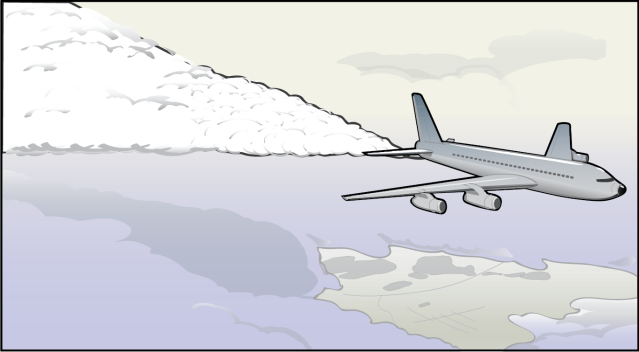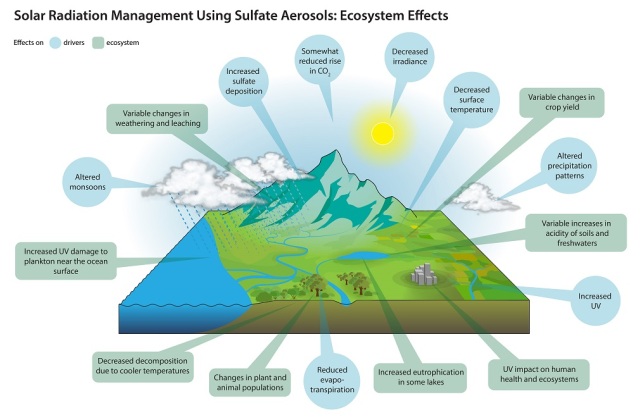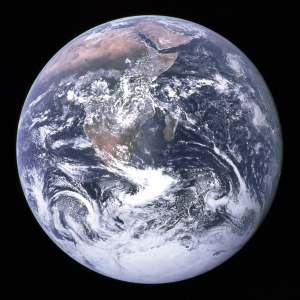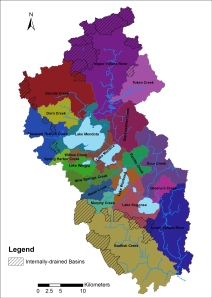Post by Steve Carpenter
As global climate change accelerates and political action stagnates, some people have suggested that we fix the climate through a massive geoengineering project. Geoengineering is the deliberate modification of earth system processes for the purpose of moderating a changing climate. For example, a fleet of jumbo jets could spray sulfate aerosols into the stratosphere to generate clouds that reflect sunlight and, thus, cool the earth.

In the Yahara 2070 scenario “Nested Watersheds,” a global coalition attempts to combat climate change through geoengineering, depicted in this illustration from the scenario. Illustration by John Miller.
To understand how geoengineering could play out in reality, looking to lessons learned from our experiences managing other natural systems can be useful. One example with strong parallels to managing the global climate is managing lake water quality.
So, what can we learn?
Writing in Nature Climate Change, a team of ecologists (myself included), economists, and political scientists argue that geoengineering will benefit some countries and harm others, but we cannot know in advance who the winners and losers will be.
For example, geoengineering is likely to cause severe floods in some regions and severe droughts in others. However, it will be very difficult to know whether these impacts could be attributed to geoengineering, already-occurring climate change, or ordinary variability in the weather.
Moreover, the countries that believe they are harmed by geoengineering could reverse-engineer the climate, or even take military action against the geoengineers. Thus, geoengineering is unstable politically. Such a breakdown is depicted in Yahara 2070’s Nested Watersheds scenario.

The schematic shows change in the drivers of ecosystem responses (blue) that might arise from the use of sulphate aerosols, given current trends of increasing greenhouse gas concentrations; the probable ecosystem responses are in green. Drivers that may change include temperature, precipitation, irradiance, monsoons and sulphate deposition. Ecosystem responses will be complex, with implications for food production, freshwater supplies, soil and water chemistry, and human health. They will also be spatially variable, creating winners and losers and possibly causing large changes in ecosystems and the availability of resources. (Caption modified from original) Source: Barrett et al. Nature Climate Change 4, 527–529 (2014)
Zooming in from the planet to the Yahara Watershed, our actions to improve water quality have some similarities to geoengineering. The effects of our watershed improvements take years to develop, while the weather and lake water quality are highly variable from year to year. Thus, it takes a long time to see a statistical pattern of change in water quality. When changes occur, it is difficult to attribute them to any individual event or management activity.
Also, benefits may be spread unevenly among the lakes. For example, Lake Mendota may respond more positively to runoff management than the lower, or downstream, lakes—i.e., Lakes Monona, Waubesa, and Kegonsa. This is because the lower lakes receive phosphorus from both upstream lakes and their own watersheds.
The most important thing is to manage the whole system, whether we are moderating the climate or fixing the Yahara lakes. In the case of the climate, the only solution that will surely work is to reduce greenhouse gas emissions over the planet as a whole. Geoengineering solutions appear to be fragmentary and politically unstable.
In the case of the Yahara lakes, the only solution that will surely work is to reduce the flow of phosphorus into all of our surface waters. Different lakes will recover at different rates, and it may take many years to achieve good water quality in all of our lakes and streams. Their waters are connected, and therefore we have to try to fix all of them together.


One thought on “Geoengineering: Parallels between the Global Climate and the Madison Lakes”